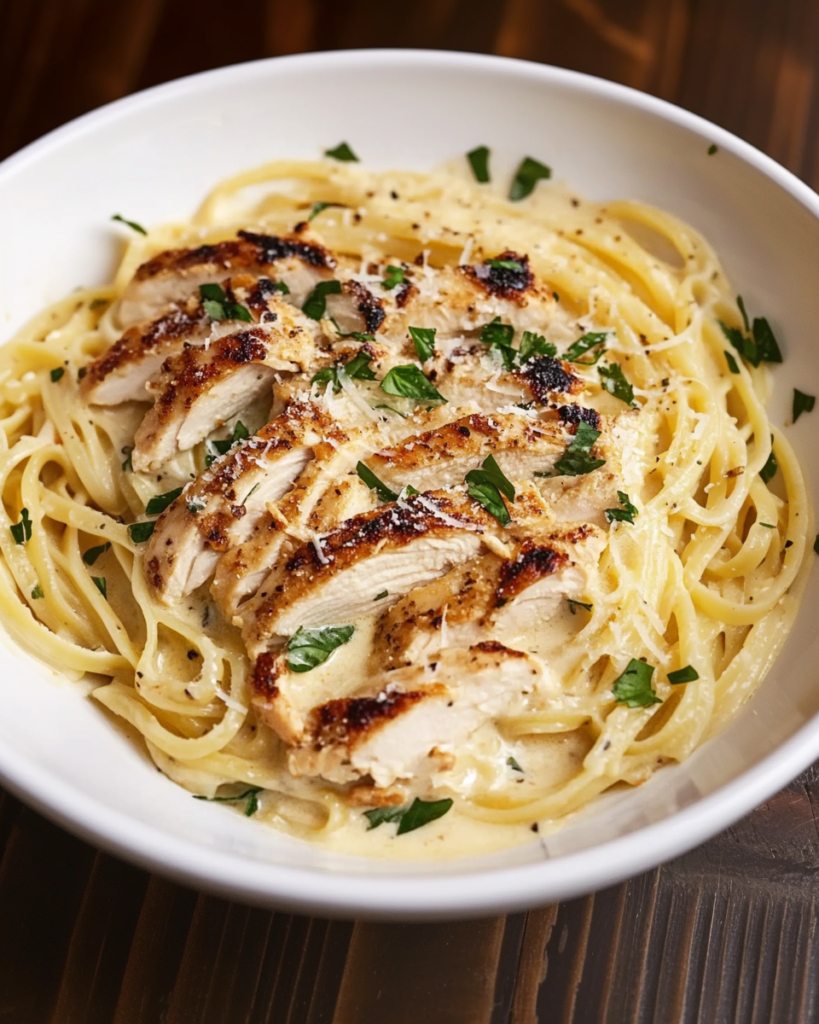
Chicken Alfredo Pasta is a classic Italian-American dish that has earned a special place in kitchens worldwide. Known for its rich, creamy sauce and tender chicken served over a bed of perfectly cooked pasta, it’s a comforting and indulgent meal that never fails to impress. This dish brings together a luscious Alfredo sauce with juicy, flavorful chicken, creating a balance of textures and flavors that appeals to both casual diners and gourmet enthusiasts alike.
Whether prepared for a family dinner or a romantic date night, Chicken Alfredo Pasta is a versatile and crowd-pleasing recipe. Its creamy texture, garlicky undertones, and the salty richness of Parmesan cheese make it a dish that satisfies both the palate and the soul. Despite its luxurious flavors, this recipe is surprisingly easy to make, requiring only a few key ingredients and simple techniques to achieve restaurant-quality results at home.
Historical Context
The Origins of Alfredo Sauce
The roots of Alfredo sauce date back to early 20th-century Rome, where Alfredo di Lelio, a restaurant owner, first created “Fettuccine Alfredo.” The original recipe was a simple combination of fresh fettuccine, butter, and Parmesan cheese. Alfredo developed this dish as a light yet satisfying meal for his pregnant wife, and its popularity soon spread among locals and tourists.
When American tourists brought the recipe back to the United States, it evolved to include heavy cream, which added richness and a smoother texture. This adaptation transformed the traditional Roman dish into the creamy Alfredo sauce widely recognized today.
Introduction of Chicken to the Dish
In Italy, Fettuccine Alfredo remains a vegetarian dish, typically served as a primo (first course). However, when the recipe crossed the Atlantic, it adapted to American dining preferences, often including chicken as the protein centerpiece. This innovation made Chicken Alfredo Pasta a complete meal, combining carbohydrates, protein, and fat into a single, hearty dish. The addition of chicken not only enhanced the flavor but also made the dish more substantial, aligning with the American preference for protein-rich meals.
Cultural Significance
Chicken Alfredo Pasta has become a staple in Italian-American restaurants and home kitchens alike. Its popularity stems from its ability to deliver comfort and sophistication in equal measure. Whether served in upscale dining establishments or as a quick weeknight dinner, the dish continues to delight people with its creamy indulgence and robust flavors.
Key Ingredients and Their Roles
The success of Chicken Alfredo Pasta lies in the careful selection and combination of its core ingredients. Each component contributes to the dish’s signature flavor and texture.
1. Chicken
- Choice of Cut: Boneless, skinless chicken breasts are the most commonly used, offering lean meat that cooks quickly. For a juicier option, boneless chicken thighs can be substituted.
- Preparation: The chicken is often seasoned with salt, pepper, and garlic powder to enhance its flavor before cooking. Grilling, baking, or pan-searing are common methods to achieve a golden, flavorful crust while retaining moisture.
2. Pasta
- Traditional Choice: Fettuccine is the classic pasta for Alfredo dishes, as its wide, flat shape holds the creamy sauce effectively.
- Alternatives: Other options include penne, linguine, or spaghetti. For a healthier twist, whole-grain or gluten-free pasta can be used.
3. Alfredo Sauce
- Butter: Creates a rich, velvety base for the sauce. Unsalted butter is preferred to allow better control of seasoning.
- Heavy Cream: Adds body and smoothness, creating a luxurious texture that clings to the pasta.
- Parmesan Cheese: The star ingredient, contributing a nutty, salty flavor. Grated fresh Parmesan ensures the best flavor and smooth incorporation into the sauce.
- Garlic: Provides depth and aroma, complementing the richness of the cream and cheese. Minced or crushed garlic is sautéed in butter to release its full flavor.
- Seasonings: Salt, freshly ground black pepper, and a pinch of nutmeg are often used to balance and enhance the sauce.
4. Additional Ingredients
- Olive Oil: Often used to sear the chicken, adding flavor and preventing sticking.
- Fresh Parsley: A traditional garnish that adds a pop of color and a fresh, herbaceous note.
- Red Pepper Flakes (Optional): Introduced for a hint of heat to balance the creamy sauce.
Essential Equipment
- Large Pot for Pasta
- A spacious pot allows the pasta to cook evenly without sticking. Adding a generous amount of salt to the water enhances the pasta’s flavor.
- Heavy-Bottomed Skillet
- Ideal for searing the chicken and preparing the Alfredo sauce. A heavy-bottomed skillet ensures even heat distribution, preventing scorching.
- Tongs
- Useful for flipping the chicken and tossing the pasta in the sauce without breaking the noodles.
- Microplane or Grater
- Essential for freshly grating Parmesan cheese, ensuring a smoother sauce.
- Whisk
- Helps achieve a lump-free Alfredo sauce by thoroughly combining the butter, cream, and cheese.
Preparation Steps
1. Cooking the Pasta
- Bring a large pot of salted water to a rolling boil. Add the pasta and cook until al dente, as it will continue cooking slightly when combined with the sauce. Reserve a cup of pasta water before draining, which can be used to adjust the sauce’s consistency later.
2. Preparing the Chicken
- Season the chicken with salt, pepper, and garlic powder. Heat olive oil in a skillet over medium-high heat. Add the chicken and cook for 4–5 minutes per side, or until golden brown and fully cooked (internal temperature of 165°F/74°C). Remove the chicken from the skillet and let it rest before slicing into thin strips.
3. Making the Alfredo Sauce
- In the same skillet, melt butter over medium heat. Add minced garlic and sauté for 30 seconds until fragrant. Pour in the heavy cream and simmer for 2–3 minutes, stirring occasionally. Gradually whisk in the Parmesan cheese until melted and smooth. Season with salt, pepper, and a pinch of nutmeg to taste.
4. Combining Pasta and Sauce
- Add the cooked pasta to the skillet with the Alfredo sauce, tossing to coat evenly. Use reserved pasta water to adjust the sauce’s thickness if needed.
5. Incorporating the Chicken
- Add the sliced chicken to the skillet, folding it gently into the pasta and sauce. Allow the mixture to heat through for 1–2 minutes.
6. Plating and Garnishing
- Serve the Chicken Alfredo Pasta immediately, garnished with freshly chopped parsley and additional grated Parmesan. Lemon wedges can be provided on the side for a hint of acidity to brighten the flavors.
Serving Suggestions
Classic Pairings
- Garlic bread or a crusty baguette is perfect for soaking up the creamy Alfredo sauce.
- A light green salad with a tangy vinaigrette provides a refreshing contrast to the dish’s richness.
Elegant Presentation
- Plate the pasta in individual servings, topping each with slices of chicken and a sprinkle of parsley. Serve with chilled white wine, such as Chardonnay or Pinot Grigio, for a sophisticated touch.
Advanced Techniques and Creative Variations
Once you’ve mastered the basics of Chicken Alfredo Pasta, there are countless ways to elevate the dish, add unique twists, and tailor it to specific tastes or occasions. This section delves into advanced techniques for perfecting the dish, explores creative variations, and offers tips for enhancing both flavor and presentation.
1. Advanced Techniques for a Perfect Dish
Achieving the Ideal Sauce Consistency
- Use reserved pasta water: Adding starchy pasta water to the Alfredo sauce helps achieve a silky texture and ensures the sauce clings beautifully to the pasta.
- Gradual cheese incorporation: To prevent clumping or a gritty texture, add Parmesan cheese in small amounts while continuously whisking over low heat.
- Avoid overheating: Keep the sauce at a gentle simmer to prevent the cream from scorching or separating.
Cooking Chicken for Maximum Flavor
- Searing: Sear the chicken over medium-high heat for a golden crust while locking in moisture. For extra flavor, use a blend of butter and olive oil.
- Brining: For incredibly juicy chicken, brine it in a saltwater solution for 30 minutes before cooking. Add herbs or garlic to the brine for additional flavor.
- Marinating: Create a simple marinade with olive oil, garlic, lemon juice, and Italian seasoning. Let the chicken marinate for 2–4 hours to infuse it with flavor.
Perfecting Pasta Cooking
- Al dente texture: Undercook the pasta slightly, as it will finish cooking in the sauce. This prevents it from becoming mushy.
- Flavored cooking water: Add a bay leaf, garlic clove, or a splash of olive oil to the pasta water for subtle flavor infusion.
Layering Flavors in the Sauce
- Infused cream: Simmer the cream with fresh herbs like thyme, bay leaves, or rosemary before adding it to the sauce. Strain before use.
- Garlic variations: Roast the garlic for a sweeter, mellower flavor or use black garlic for an umami boost.
- Add wine: Deglaze the pan with dry white wine before adding cream for added depth. Let the wine reduce by half to concentrate its flavor.
2. Creative Flavor Variations
Herb-Infused Alfredo
- Incorporate fresh herbs like basil, oregano, or tarragon into the sauce for a fragrant twist.
- Use herb butter instead of plain butter to infuse the dish with additional layers of flavor.
Lemon Garlic Alfredo
- Add the juice and zest of one lemon to the Alfredo sauce for a bright, tangy kick.
- Combine with extra garlic for a zesty, aromatic variation.
Vegetable-Enhanced Alfredo
- Add sautéed spinach, steamed broccoli, or roasted asparagus to the dish for a pop of color and added nutrients.
- Include sun-dried tomatoes or roasted red peppers for a touch of sweetness and a Mediterranean flair.
Spicy Alfredo
- Add crushed red pepper flakes, cayenne pepper, or a dash of hot sauce for a spicy kick.
- For a smoky heat, include chipotle powder or smoked paprika in the sauce.
Cheesy Alfredo
- Experiment with different cheeses like Romano, Asiago, or Fontina for a more complex flavor profile.
- Sprinkle blue cheese crumbles over the finished dish for a bold twist.
Pesto Alfredo
- Swirl in a few tablespoons of basil pesto for a vibrant, herbaceous flavor.
- Garnish with toasted pine nuts for added texture.
Mushroom Alfredo
- Add sautéed cremini, shiitake, or porcini mushrooms to enhance the dish’s earthy richness.
- Deglaze the pan with Marsala wine before making the sauce for a sophisticated touch.
3. Protein Substitutions and Additions
Seafood Alfredo
- Replace chicken with shrimp, scallops, or lobster for a luxurious seafood version.
- Cook the seafood separately and fold it into the sauce just before serving to avoid overcooking.
Vegetarian Alfredo
- Omit the chicken and add roasted vegetables, tofu, or plant-based protein for a vegetarian alternative.
- Consider tempeh or jackfruit for a meat-like texture.
Surf and Turf Alfredo
- Combine chicken with shrimp or crab for a decadent surf-and-turf variation.
- Top the dish with seared steak medallions for a hearty twist.
Smoked or Grilled Chicken
- Use smoked chicken or grill the chicken over charcoal for a smoky flavor that adds depth to the dish.
4. Dietary Modifications
Low-Fat Alfredo
- Replace heavy cream with a mixture of low-fat milk and cornstarch.
- Use light cream cheese or Greek yogurt for a creamy texture with fewer calories.
Dairy-Free Alfredo
- Substitute butter with vegan butter or olive oil, and use coconut cream or cashew cream for the sauce.
- Nutritional yeast adds a cheesy flavor without dairy.
Gluten-Free Alfredo
- Serve with gluten-free pasta made from rice, quinoa, or chickpeas.
- Use cornstarch or arrowroot powder to thicken the sauce instead of flour.
Keto-Friendly Alfredo
- Replace pasta with zucchini noodles, spaghetti squash, or shirataki noodles for a low-carb option.
- Increase the amount of butter and Parmesan for a richer, keto-friendly sauce.
5. Presentation and Serving Ideas
Elegant Plating Techniques
- Twist the pasta into a neat mound on each plate using tongs for a polished presentation.
- Arrange sliced chicken on top and drizzle with extra sauce. Garnish with parsley and freshly grated Parmesan.
Family-Style Serving
- Serve Chicken Alfredo Pasta in a large, shallow dish with the chicken arranged in the center.
- Provide extra sauce on the side for guests to customize their plates.
Garnishing Tips
- Use fresh basil leaves, microgreens, or edible flowers for a sophisticated touch.
- Sprinkle crispy pancetta or breadcrumbs over the dish for added texture and flavor.
6. Pairing Suggestions
Side Dishes
- Salads: A crisp Caesar salad or arugula salad with lemon vinaigrette balances the dish’s richness.
- Vegetables: Roasted Brussels sprouts, green beans, or asparagus make excellent sides.
Beverages
- Wines: Pair with a full-bodied Chardonnay, Sauvignon Blanc, or light Pinot Noir.
- Non-Alcoholic Options: Lemon-infused sparkling water, iced tea with a hint of mint, or a light citrus mocktail.
Breads
- Serve with garlic knots, focaccia, or a warm baguette to soak up the creamy sauce.
7. Leftover Transformations
Alfredo Pasta Bake
- Combine leftovers with additional cheese and breadcrumbs. Bake at 375°F (190°C) until bubbly and golden.
Alfredo Soup
- Thin the Alfredo sauce with chicken broth and add cooked chicken, pasta, and vegetables for a comforting soup.
Stuffed Bell Peppers
- Fill halved bell peppers with Alfredo pasta, top with mozzarella, and bake until the peppers are tender.
Alfredo Pizza
- Use the sauce as a base for pizza dough, top with chicken, mozzarella, and spinach, then bake until crispy.
Alfredo-Stuffed Crepes
- Fill savory crepes with the pasta and chicken mixture, roll them up, and drizzle with extra sauce.
Chicken Alfredo Pasta: Part 3
Storing, Reheating, and Creative Leftover Ideas
Chicken Alfredo Pasta is a dish that remains delicious even as leftovers, offering opportunities for repurposing and recreating new meals. Proper storage and reheating techniques ensure the creamy sauce and tender chicken stay flavorful and fresh. This section explores best practices for storage, reheating, and inventive ways to transform leftovers into entirely new dishes.
1. Storing Chicken Alfredo Pasta
Refrigeration
- Allow the dish to cool to room temperature before transferring it to an airtight container.
- Store pasta and sauce together, or keep them separate if possible, to maintain the pasta’s texture.
- Refrigerate for up to 3–4 days to ensure optimal freshness.
Freezing
- Alfredo sauce can be frozen, though its texture may change slightly due to the cream content. For best results:
- Freeze the sauce and pasta separately.
- Place the sauce in a freezer-safe container, leaving some space for expansion.
- Store cooked chicken in a separate bag or container for easy reheating.
- Label containers with the date and freeze for up to 2 months.
Thawing Frozen Alfredo
- Transfer the frozen sauce to the refrigerator and let it thaw overnight. Reheat gently to restore its creamy consistency.
2. Reheating Chicken Alfredo Pasta
Stovetop Method (Best for Sauce Texture)
- Heat a skillet over medium-low heat and add the pasta with a splash of milk, cream, or chicken broth.
- Stir continuously to re-emulsify the sauce and prevent it from separating.
- Add the chicken and heat gently until warmed through.
Microwave Method (Quick and Convenient)
- Place the pasta in a microwave-safe dish, covering it loosely with a lid or microwave-safe wrap.
- Add a tablespoon of milk, cream, or broth to prevent the sauce from drying out.
- Heat in 30-second intervals, stirring between each interval to ensure even reheating.
Oven Method (For Large Quantities)
- Preheat the oven to 350°F (175°C). Place the pasta in an oven-safe dish and cover it with aluminum foil.
- Bake for 20–25 minutes, stirring halfway through. Add extra liquid if the sauce appears too thick.
Reheating Tips
- Avoid overheating Alfredo sauce, as it can cause the butter and cream to separate.
- Stir frequently and use low to medium heat for the best results.
3. Creative Leftover Transformations
Transforming leftover Chicken Alfredo Pasta into new dishes adds variety and ensures no food goes to waste.
Alfredo Casserole
- Combine leftovers with steamed broccoli, cooked spinach, or roasted vegetables.
- Transfer to a casserole dish, top with breadcrumbs and grated Parmesan, and bake at 375°F (190°C) until golden and bubbly.
Stuffed Peppers
- Hollow out bell peppers and stuff them with Alfredo pasta.
- Top with shredded mozzarella and bake until the peppers are tender and the cheese is melted.
Alfredo Pizza
- Spread Alfredo sauce over a pizza crust as the base.
- Add shredded chicken, mozzarella, spinach, and sun-dried tomatoes. Bake until crispy and golden.
Creamy Alfredo Soup
- Thin the sauce with chicken broth and add diced potatoes, carrots, or celery.
- Stir in leftover chicken and pasta, simmering until heated through for a comforting soup.
Chicken Alfredo Wraps
- Use the pasta and sauce as a filling for tortillas or flatbreads.
- Add arugula, sliced tomatoes, or avocado for a fresh twist.
Alfredo Mac and Cheese
- Stir the leftovers with additional cream and cheese to create a decadent mac and cheese dish.
- Top with breadcrumbs and broil for a crispy crust.
Alfredo-Stuffed Crepes
- Fill savory crepes with the pasta mixture, roll them up, and drizzle with extra sauce before serving.
Rice or Grain Bowl
- Replace the pasta with cooked rice, quinoa, or farro for a hearty grain bowl.
- Add sautéed vegetables or roasted sweet potatoes for texture and flavor.
Chicken Alfredo Pie
- Use the pasta as a filling for a savory pie. Line a pie dish with puff pastry, fill it with Alfredo pasta, and bake until the crust is golden.
Croquettes or Fritters
- Mix the leftovers with breadcrumbs and an egg to form a thick batter.
- Shape into patties or balls, then fry until golden brown. Serve with a fresh salad or dipping sauce.
4. Frequently Asked Questions (FAQs)
Can I freeze Chicken Alfredo Pasta?
- Yes, but for best results, freeze the sauce, chicken, and pasta separately. Reheat gently to restore the creamy texture.
How can I prevent the sauce from separating during reheating?
- Reheat slowly over low heat, stirring frequently. Adding a splash of milk, cream, or broth can help bring the sauce back together.
What’s the best way to store leftovers?
- Store in an airtight container in the refrigerator within 2 hours of cooking. If freezing, use freezer-safe containers or bags and label them with the date.
Can I make Chicken Alfredo ahead of time?
- Yes, prepare the components separately. Cook the pasta and chicken, then store them with the sauce in separate containers. Combine and heat just before serving for the freshest taste.
How long can leftovers be stored?
- Refrigerated leftovers can be kept for up to 3–4 days. Frozen Alfredo can last up to 2 months if stored properly.
What if my Alfredo sauce is too thick after reheating?
- Add a splash of milk, cream, or pasta water to thin the sauce to your desired consistency. Stir gently to incorporate.
Can I use different proteins in Alfredo?
- Absolutely! Shrimp, scallops, sausage, or plant-based proteins like tofu or seitan work well in Alfredo dishes.
Can I add wine to Alfredo sauce?
- Yes, a splash of dry white wine can enhance the sauce’s depth of flavor. Add it after sautéing garlic and let it reduce before adding cream.
Conclusion
Chicken Alfredo Pasta is not only a timeless comfort food but also a versatile dish that lends itself to countless variations and creative uses for leftovers. With proper storage and reheating techniques, you can enjoy its creamy, indulgent flavors for days. Transforming leftovers into new dishes, from casseroles to pizzas, ensures that every bite is as exciting as the first. Whether served fresh or reinvented, Chicken Alfredo Pasta continues to be a culinary favorite that satisfies every time.
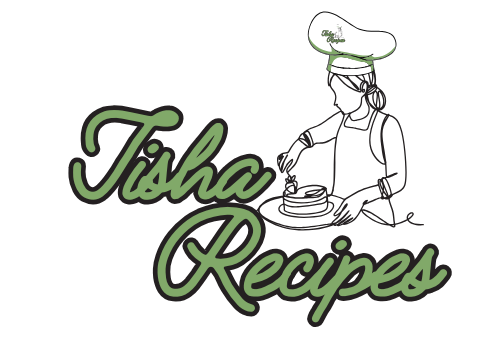
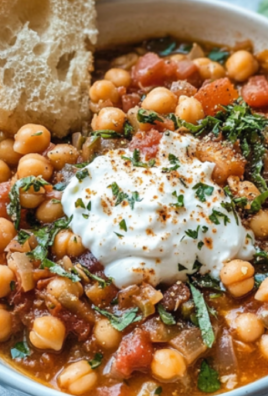
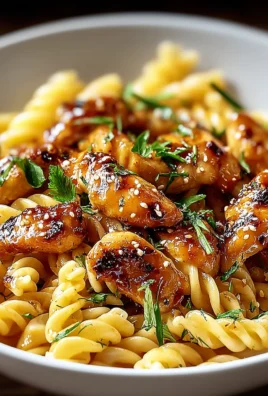
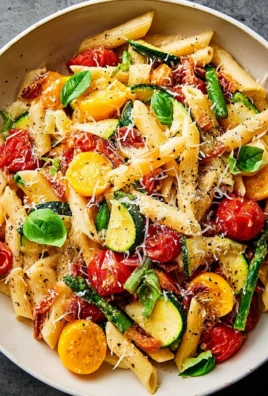
Leave a Comment